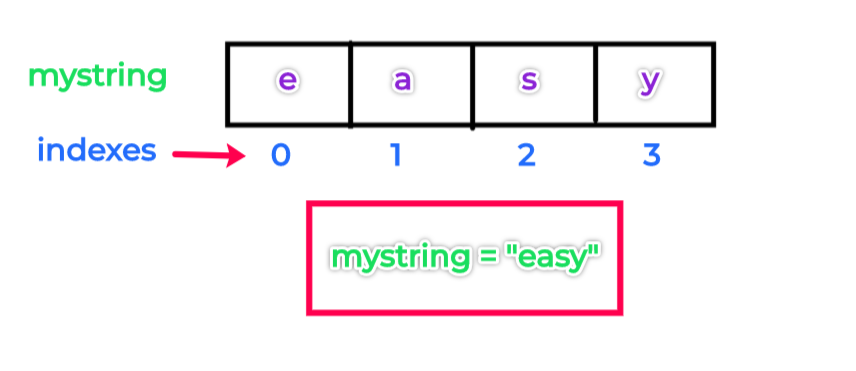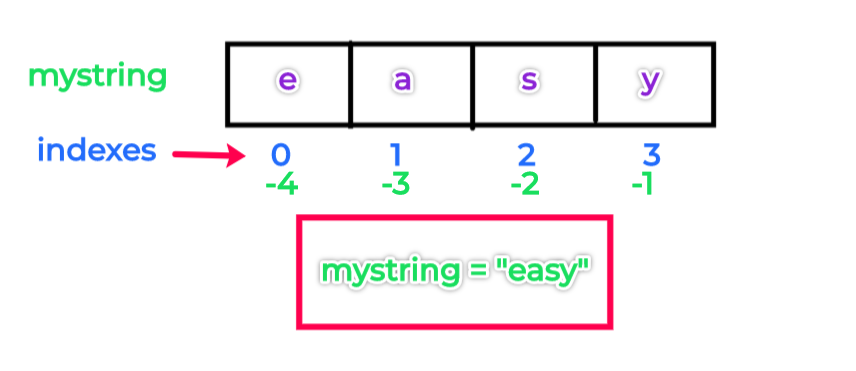Python Strings
Table of Contents
Python String Datatype
A string literal is simply a list of characters (textual data) in sequence surrounded by
quotes.
A character can be anything like numbers, backslash or letters and can also have
space.
For example,"easy"is a string.
It is a four character long
with each characters in sequence "e", "a", "s", "y"
We
can assign the same string to a variable as follows
mystring = "easy" # create a 4 character string objects and assign it to name "mystring"
mystring is the variable name to which the string object is assigned.
There are fours
ways you can declare a string literal (or create a string object) in Python i.e. single quotes ('),
double quotes ("), triple double quotes (""") and triple single quotes (''')
Example:
string1 = 'It is a single quoted string'
string2 = "It is a double quoted string"
string3 = """It is a triple double quoted string"""
string4 = '''It is a triple single quoted string'''
multiline_string1 = """
This is a
sting in multiple lines
"""
multiline_string2 = '''
This is a
sting in multiple lines
'''
unicode_string = u'e\xc4sy'
print(type(string1))
print(type(unicode_string))
type() - is a built-in function which returns the type to which the
object belongs. Refer to https://docs.python.org/3.7/library/functions.html#type
multilinestring1
and multilinestring2 are multi-line string literals. We can write multiple line
texts/string using triple double quotes (""") and triple single quotes (''')
unicodestring
is unicode string literal.
Indexing in Python String
The characters are stored in order or sequence in the memory with a particular position assigned
to each of the character.
The positions or the offsets are known as index.
Example:
mystring = "easy" # create a 4 character string objects and assign it to name "mystring"
 The first item or
character "e" is at index 0 and the second item "a" is at index 1 ans so
on
The first item or
character "e" is at index 0 and the second item "a" is at index 1 ans so
onItems or characters from the string can be retrieved by using the name ( e.g. mystring ) and these indexes. The process is called indexing
As "e" is at index 0 we can retrieve and print "e" using name mystring as follows
print(mystring[0])
To retrieve "a" and others
print(mystring[1])
print(mystring[2])
print(mystring[3])
Negative Index
we can also index backward. The above positive indexes from 0, 1, 2 and so on -count form left to
right
The negative index count from right to left starting with -1 e.g. -1, -2, -3.
So
from the previous example mystring = "easy",
 if we want to retrieve
"a" using mystring and negative index we can write
if we want to retrieve
"a" using mystring and negative index we can write
print(mystring[-3]) # is same as mystring[1]
So the value at 1 is same as -3 and 0 is as index -4
Slicing
We can also extract a portion of a string using indexes know as slicing.
The syntax is
variable_name[I:J] # Gives everything in variable_name from I to J, but inot including J
Example:
print(mystring[1:3])
So it extracts the string from offset/index 1 to 2 (Not including 3)
Python String Operators
Python has a set of built-in methods that you can use on strings"+" - Concatenation Operator
>>> string1 = "py"
>>> string2 = "thon"
>>> string1 + string2
'python'"*" - Repetition Operator
>>> str_1 = "Python"
>>> str_1 * 3
'PythonPythonPython'"r / R" - Raw string Operator
Example:
>>> print('thi \nis ')
thi
is
>>> print(r'thi \nis ')
thi \nis
>>> print(R'thi \nis ')
thi \nisWithout the raw string operator, the 'is' printed in the next line
"in" - Membership Operator
Example:
>>> str_1 = "Python"
>>> "th" in str_1
True"not in" - Membership Operator
Example:
>>> str_1 = "Python"
>>> "a" not in str_1
True
>>> "on" not in str_1
False"%" - Format Operator
Refer to - https://docs.python.org/2/library/stdtypes.html#string-formatting
Example:
>>> str_1 = "Python %s easy" % ('is')
>>> str_1
'Python is easy'
>>> str_2 = 'Today is %dth Nov' % 14
>>> str_2
'Today is 14th Nov'"[]" - Slice Operator
Example:
>>> str_1 = "Python"
>>> str_1[2]
't'"[:]" - Range Slice Operator
Example:
>>> str_1 = "Python"
>>> str_1[2:4]
'th'Python String methods
Python has a set of built-in methods that you can use on stringsstr.count()
Returns the number of non-overlapping occurrences of substring>> string1 = "pythoneasy is python website"
>> string1.count('python')
2
str.find()
Returns the lowest index in the string where substring sub is found>> string1 = "pythoneasy is python website"
>> string1.find('on')
4
str.upper()
Converts a string to uppercase, returns new string>>> string1 = "python is easy"
>>> string1.upper()
'PYTHON IS EASY'
str.lower()
Converts a string to lowercase, returns new string>>> string1 = "PYTHON IS EASY"
>>> string1.lower()
'python is easy'
str.swapcase()
Return a copy of the string with uppercase characters converted to lowercase and vice versa.>>> string1 = "Python Is Easy"
>>> string1.swapcase()
'pYTHON iS eASY'
str.title()
Returns a titlecased version of the stringExample:
>>> string1 = "python is easy"
>>> string1.title()
'Python Is Easy'
str.capitalize()
Returns a copy of the string with its first character capitalized and the rest lowercased.>>> phrase = 'lexical semantics'
>>> phrase.capitalize()
'Lexical semantics'str.strip()
Return a copy of the string with the leading and trailing characters removed.>>> string1 = " python is easy "
>>> string1
' python is easy '
>>> string1.strip()
'python is easy'str.join(iterable)
Returns a string which is the concatenation of the strings in iterable>>> list_1 = ['python', 'is', 'easy']
>>> ''.join(list_1)
'pythoniseasy'
>>> ' '.join(list_1)
'python is easy'
>>> print('\n'.join(list_1))
python
is
easy
>>> print('\t'.join(list_1))
python is easystr.split(sep)
Returns a list of the words in the string, using sep as the delimiter string>>> string_1 = ' 1 2 3 '
>>> string_1.split()
['1', '2', '3']
>>> string_1 = ' 1 in 2 in 3 '
>>> string_1.split('in')
[' 1 ', ' 2 ', ' 3 ']